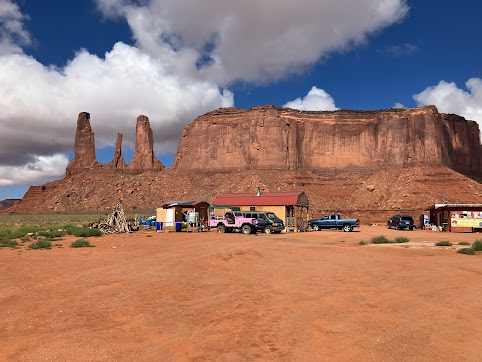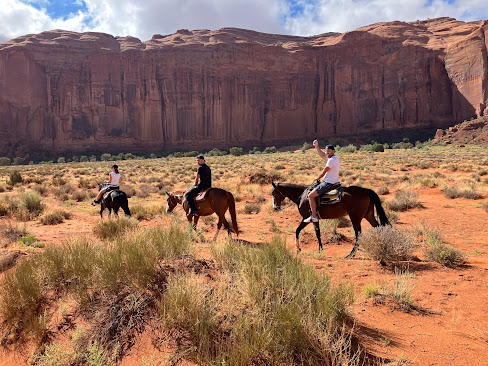We love to take our Mini on scenic drives, and we had planned to drive through Monument Valley this morning on Valley Drive. It is a 17-mile loop road and it sounded like a beautiful drive.
Monument Valley is not officially a National Park because it sits within the Navajo Nation; it is technically the Monument Valley Navajo Tribal Park. As we approached the Park, we were having some second thoughts about the scenic drive. We learned that the road was not paved, and our Mini does not do well on low-clearance roads like that. So we checked in with Dineh Bekeyah Tours at the entrance to the Tribal Park and soon found ourselves in the back of a vehicle more suited to the terrain.
We were the only passengers on the tour, and our driver
was a young Navajo man named Jamison. It
soon became apparent that (1) he knew Monument Valley inside out and (2) the
road was no place for a Mini Cooper. In
fact, we would not have attempted it in our All-Wheel-Drive Honda CRV. It was, I think, the roughest road I have
ever traveled; we bumped up and down and swayed from side to side and grabbed the
steel bar in front of us with white knuckles, and I was thankful that our Mini was safely
parked back at the Tour headquarters. We
passed several other private vehicles, like a Subaru Forrester, that looked like
they were struggling and had regretted the decision to attempt the drive. There must be a busy towing service operating in the Park.
Jamison had a wealth of information about the valley and the Navajo people who lived in this sparsely-populated area. He told us that many movies had been filmed here, including Back to the Future. We had seen the movie a long time ago, and I went to YouTube and found some clips that reminded me that Marty and Doc had indeed been pursued by hostile Native Americans when they materialized in their time-traveling DeLorean.
The scenery in the movie was exactly what we were seeing all around us, tall, stunning mesas and rock formations unlike anything we had seen thus far. We stopped along the way for a restroom break where Native American jewelry and fry bread were on hand.
Some folks were taking a horseback tour, and
they waved at us as we drove by. That
would have been the preferred way to see this place, I thought, if only I had
decided long ago that I am not a horseback rider. But the slow ambling pace through the sagebrush past these mesas, which did indeed look like monuments, would have been perfect.
Jamison stopped at one point and showed us the
Money Tree, an ancient cedar with grooves up and down the horizontal part of its
trunk into which travelers tuck a coin for good luck. And then – the highlight of the tour for both
of us – he pulled a flute from his pocket made from the same wood and played us
a haunting Navajo tune. It reminded me
of recordings I have heard of Carlos Nakai.
We left Monument Valley and continued east to our next National Park. It was desolate country, with only a few small isolated cabins and campers along the way, usually next to a power pole. I wondered where their water came from, and how they survived out here. We came to a formation called Mexican Hat that looked like a sombrero balanced atop a crooked stone column. There were oil derricks out here, too, scattered between the sagebrush, and we passed through tiny towns: Dennehotso, Mexican Water, Red Mesa.
Part of our route, State Route 264, was the Navajo Code Talker Highway, named after the Navajo who had created a code based on the complex, unwritten Navajo language during World War II. We crossed the state line into Colorado and began climbing into different country. This was open range out here, and some free range horses were grazing along the road.
It had not rained for a very long time in this part of the country, and there was no sign of water at all. But so-called dry gulches were still green, winding down in the low places along the road where there likely was still water beneath the surface. There were a few ranches but not many homes. Martha spotted something curious at an overlook along the road: a Little Library, way out here in the middle of nowhere! We looked inside and found several books that seemed way out of place in this landscape, like The Old Wine Shades (the name of a London pub) by Martha Grimes.
We stopped in a pretty little city, Cortez, for a cold beer in the Main Street Brewery. It was an interesting place, with humorous signs posted all around the walls, like Never approach a bull from the front, a horse from the rear, or a fool from any direction. On a TV in the corner, an old Western TV Show was showing in black and white – Bat Masterson. I remembered watching it as a boy, and we recalled all of our other favorite westerns that we had grown up watching: Gunsmoke, of course, and Bonanza, and my personal favorite, Have Gun Will Travel. We climbed higher and higher into a different kind of country, mesas with very steep slopes, finally topping out at 8,100 feet.
Our hotel for the night was Far View Lodge, the only hotel in Mesa Verde National Park. Martha had made reservations at the hotel restaurant, the Metate Room, and it was delicious, with distant views of the countryside. It reminded us of one of our favorite places, Pisgah Inn.
When we came out of the restaurant to walk the few feet to our room, I stopped to examine a shrub that had been growing profusely in the area, which I identified as Rabbitbrush. It looked like goldenrod, and I found that it could cause similar allergies (I had been feeling as if I was allergic to something). While I was occupied taking a photo of a shrub, Martha said, “Look!” and pointed across the road where three beautiful horses were calmly grazing. We asked about them later and found that wild horses roam the western slopes of the Rockies, and they find the grass at the Lodge especially tasty.
.PNG)





.jpg)
.jpg)
.jpg)
.jpg)

.jpg)
No comments:
Post a Comment